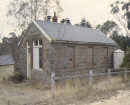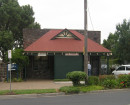RAIL BRIDGE
MONBULK CREEK, BELGRAVE-GEMBROOK ROAD BELGRAVE, YARRA RANGES SHIRE
-
Add to tour
You must log in to do that.
-
Share
-
Shortlist place
You must log in to do that.
- Download report


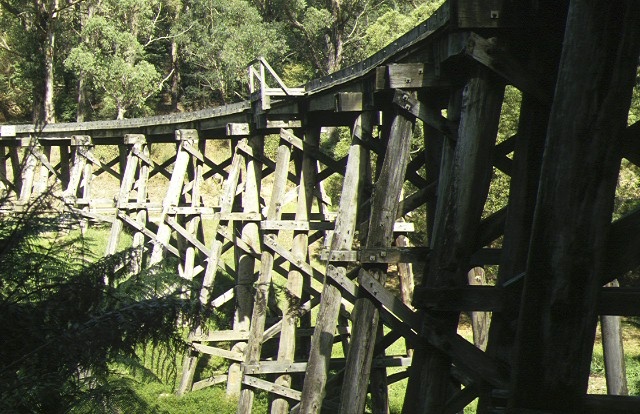

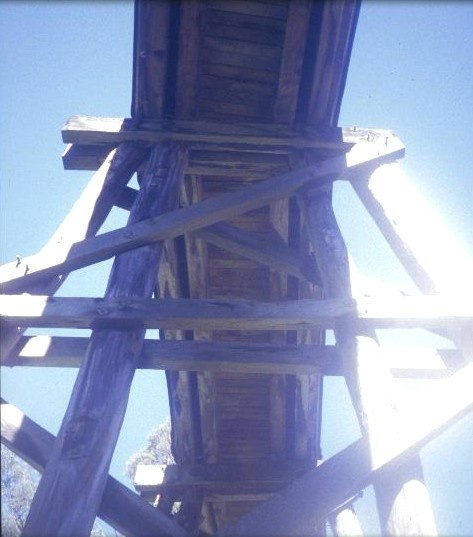
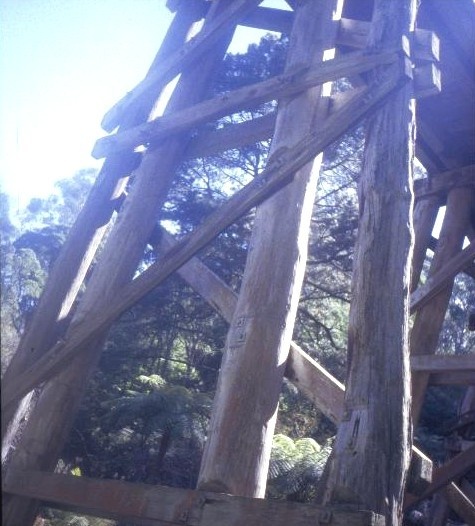
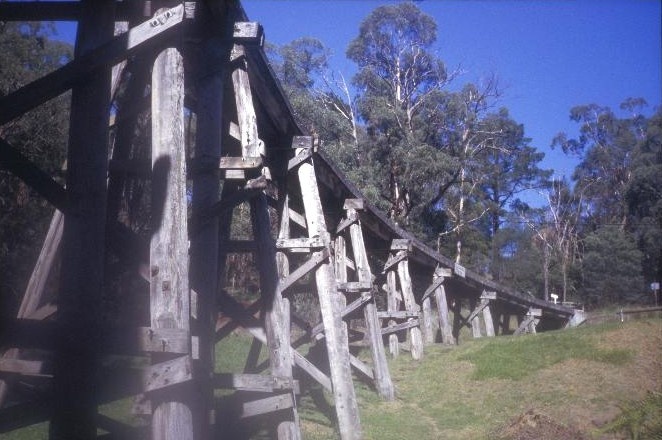
Statement of Significance
What is significant?
In 1899 construction of the Ferntree Gully-Gembrook Line began which included the Rail Bridge, over Monbulk Creek, Selby. Victoria Railways architects designed the line and The Board of Lands and Works Construction Branch employed one hundred and eighty men for a period of sixteen months, many of them local timber workers, as labour. One of the features of the construction of the railway, and in particular the Trestle Bridge, was the use of construction methods which utilised native bush timbers. These were not in ready supply at this time as the area had been devastated by bushfire in 1898. The narrow gauge line supplied local people with goods and services on a regular basis and provided reliable access to markets for local industries as well as revitalising the tourist industry in the picturesque hills. In 1954 the narrow gauge line was closed and in 1958 management of the line was handed over to The Puffing Billy Preservation Society. The Puffing Billy steam train services began on the line in 1965 as a tourist concern. In 1977 the ownership of the line was handed over to the Tourist Railway Board. The Rail Bridge, over Monbulk Creek, Selby is a curved, timber trestle bridge carrying a single narrow gauge track which spans the Monbulk Creek and the Belgrave Emerald Rd. A viewing bay has been constructed for tourists, off Belgrave-Emerald Rd. The bridge is 85 metres long, 12 metres high at its highest point and comprises 14 spans of 6 metres, curved to a radius of 20 metres. The bridge has a tight 3 chain curvature. It was constructed from local, native bush timbers. The bridge has undergone progressive replacement of damaged timbers. Major structural repair and conservation works were carried out in 1983 and 1988.
How is it significant?
The Rail Bridge, over Monbulk Creek, Selby is of historical, social and architectural importance to the State of Victoria.
Why is it significant?
The Rail Bridge, over Monbulk Creek is of historical importance for its association with the construction of narrow gauge railway lines in Victoria. During the 1890s depression, broad gauge railway line construction was not considered economically viable and the Parliamentary Standing Committee on Railways in 1896 considered alternative railway construction techniques. Following the committee's recommendations, four narrow gauge rail lines were built in Victoria between 1899 and 1916. The Rail Bridge is an important component of the former narrow gauge Ferntree Gully-Gembrook Line. The bridge is also of historical importance for its association with the economic stimulus the narrow gauge railway generated in the Dandenongs. Businesses that benefited included the Nobelius Nurseries, which became the largest nursery in the Southern Hemisphere in the pre World War One period. The timber, tourism and soft fruit industries also benefited from the lines' construction.
The Rail Bridge, over Monbulk Creek is historically and socially important for its association with the recreational tourism industry in Victoria. The journey into the hills, including the ride over this famous bridge, became a popular weekend recreational activity enjoyed by local and overseas visitors from the lines' initial construction in 1899, and after its reopening as the Puffing Billy Line in 1965. The bridge is socially important for its associations with the community movement to protect and restore the narrow gauge line from the 1950s. This movement is an example of community concern over heritage issues which developed within parts of the Victorian community in the post war period.
The Rail Bridge, over Monbulk Creek is architecturally important because it is an essentially intact example of a timber trestle bridge and is possibly the most extremely curved surviving bridge in Victoria. It is also significant as an example of trestle bridge construction, using construction methods which utilised local native timbers.
-
-
RAIL BRIDGE - History
The bridge is historically significant as an important element on the historic 'Puffing Billy', narrow gauge railway line and in the surrounding landscape. The opening of the line was significant for its role in providing a stimulus for primary producers such as Carl Alex Nobelius, whose nursery became the largest in the Southern Hemisphere. (Beeston, 1995)
The Railway Bridge over Monbulk Creek, Selby was constructed in 1899 on the narrow gauge Ferntree Gully - Gembrook Line, by the Board of land and Works. It consists of 14, 20’ spans supported on timber trestles on a tight curvature, carrying the historic Puffing Billy single narrow gauge railway line over Monbulk Creek and the Belgrave-Emerald Road .
The Railway Trestle Bridge over Monbulk Creek near Selby is of significance as an important element on the historic ‘Puffing Billy’ narrow gauge railway line and in the surrounding landscape. It is a representative example of one of the four 2’ 6” lines to be constructed in Victoria, all in mountainous locations. The railway structure is a rare and essentially intact example of a timber trestle railway bridge in Victoria. It is also significant as a notable example of timber trestle bridge construction. It demonstrates a distinctive and now rarely used construction method that utilised native bush timbers .
The opening of the line was significant for its role in providing a stimulus for primary producers such as Carl Alex Nobelius, whose nursery became the largest in the southern hemisphere .
COMPARISON:
Timber Trestle Railway Bridges currently on the Victorian Heritage Register
H1435, Railway Bridge, South of Noojee-Powell Town Rd, Noojee, 1919, timber trestle, 18 span
H1436, Railway Bridge Orbost-Bairnsdale Line, Nowa Nowa, 1916, timber trestle
H1442, Railway Bridge over Curdies River, Curdie’s Siding, Timboon, 1892, timber trestle, 31 span
H1695, Railway Bridge over Hanfords Creek, Wandong-Bendigo Railway Line, Pyalong, 1890, timber trestle
H1451, Railway Bridge over Mollison’s Creek, Wandong-Bendigo Railway Line, Pyalong, 1889, timber trestle, 26 span
There are five other timber railway bridges listed on the Victorian Heritage Register. Two located at Pyalong (1889 and 1890), Timboon (1892), Nowa Nowa (1916) and Noojee (1919). The Selby Trestle Bridge is the only trestle bridge on a narrow gauge line which is still in regular use as part of a working steam rail line. It is the most extremely curved timber trestle bridge surviving in Victoria.
Associated People: Carl Alex Nobelius, whose nursery became the largest in the Southern Hemisphere. (Beeston, 1995)RAIL BRIDGE - Permit Exemptions
General Exemptions:General exemptions apply to all places and objects included in the Victorian Heritage Register (VHR). General exemptions have been designed to allow everyday activities, maintenance and changes to your property, which don’t harm its cultural heritage significance, to proceed without the need to obtain approvals under the Heritage Act 2017.Places of worship: In some circumstances, you can alter a place of worship to accommodate religious practices without a permit, but you must notify the Executive Director of Heritage Victoria before you start the works or activities at least 20 business days before the works or activities are to commence.Subdivision/consolidation: Permit exemptions exist for some subdivisions and consolidations. If the subdivision or consolidation is in accordance with a planning permit granted under Part 4 of the Planning and Environment Act 1987 and the application for the planning permit was referred to the Executive Director of Heritage Victoria as a determining referral authority, a permit is not required.Specific exemptions may also apply to your registered place or object. If applicable, these are listed below. Specific exemptions are tailored to the conservation and management needs of an individual registered place or object and set out works and activities that are exempt from the requirements of a permit. Specific exemptions prevail if they conflict with general exemptions. Find out more about heritage permit exemptions here.Specific Exemptions:EXEMPTIONS FROM PERMITS:
(Classes of works or activities which may be undertaken without a permit under
Part 4 of the Heritage Act 1995)
General Conditions
1. All exempted alterations are to be planned and carried out in a manner
which prevents damage to the fabric of the registered place or object.
2. Should it become apparent during further inspection or the carrying out of
alterations that original or previously hidden or inaccessible details of the
place or object are revealed which relate to the significance of the place or
object, then the exemption covering such alteration shall cease and the
Executive Director shall be notified as soon as possible.
3. If there is a conservation policy and plan approved by the Executive
Director, all works shall be in accordance with it.
4. Nothing in this declaration prevents the Executive Director from amending
or rescinding all or any of the permit exemptions.
5. Nothing in this declaration exempts owners or their agents from the
responsibility to seek relevant planning or building permits from the
responsible authority where applicable.
* No permit required for routine maintenance of the Rail Bridge, over Monbulk
Creek
* No permit required to replace like with like on the Rail Bridge, over
Monbulk Creek
-
-
-
-
-
PUFFING BILLY LOCOMOTIVES AND ROLLING STOCK
 Victorian Heritage Register H2187
Victorian Heritage Register H2187 -
EC-5 YANAKIE HOMESTEAD
 Victorian Heritage Inventory
Victorian Heritage Inventory -
Puffing Billy Trestle Bridge
 National Trust H2187
National Trust H2187
-
13 Flinders Street, Queenscliff
 Queenscliffe Borough
Queenscliffe Borough -
162 Nicholson Street
 Yarra City
Yarra City -
164 Nicholson Street
 Yarra City
Yarra City
-
-






